2017 Peugeot 308 brake
[x] Cancel search: brakePage 28 of 566
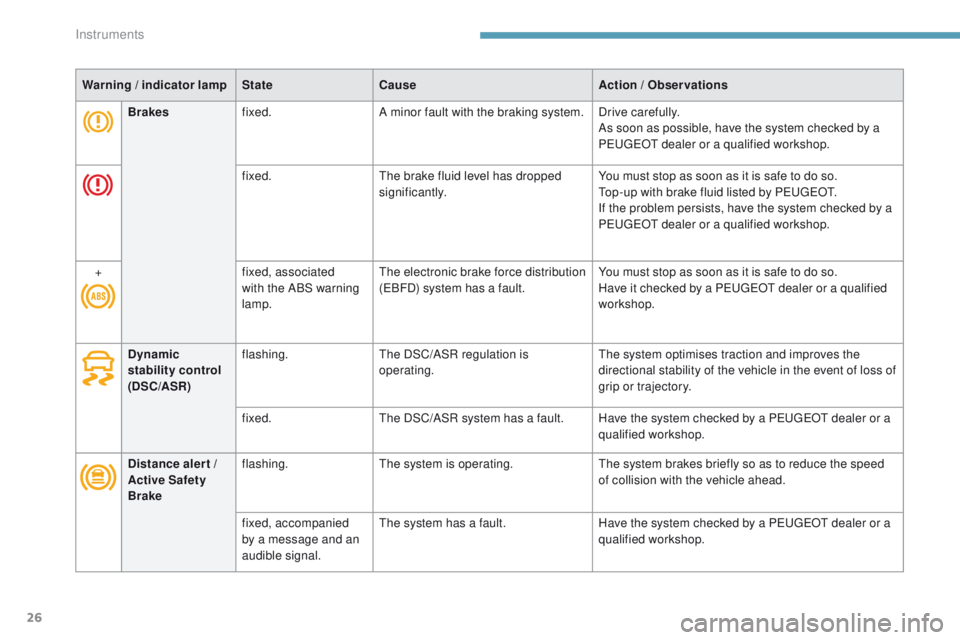
26
3008-2_en_Chap01_instruments-de-bord_ed01-2016
Warning / indicator lampStateCause Action / Observations
Brakes fixed. A minor fault with the braking system. Drive carefully.
As soon as possible, have the system checked by a
PEUGEOT dealer or a qualified workshop.
fixed. The brake fluid level has dropped
significantly. You must stop as soon as it is safe to do so.
Top-up with brake fluid listed by PEUGEOT.
If the problem persists, have the system checked by a
PEUGEOT dealer or a qualified workshop.
+ fixed, associated
with the ABS warning
lamp.The electronic brake force distribution
(EBFD) system has a fault.
You must stop as soon as it is safe to do so.
Have it checked by a PEUGEOT dealer or a qualified
workshop.
Dynamic
stability control
(DSC/ASR) flashing.
The DSC/ASR regulation is
operating. The system optimises traction and improves the
directional stability of the vehicle in the event of loss of
grip or trajectory.
fixed. The DSC/ASR system has a fault. Have the system checked by a PEUGEOT dealer or a
qualified workshop.
Distance aler t
/
Active Safety
Brake flashing.
The system is operating. The system brakes briefly so as to reduce the speed
of collision with the vehicle ahead.
fixed, accompanied
by a message and an
audible signal. The system has a fault.
Have the system checked by a PEUGEOT dealer or a
qualified workshop.
Instruments
Page 48 of 566
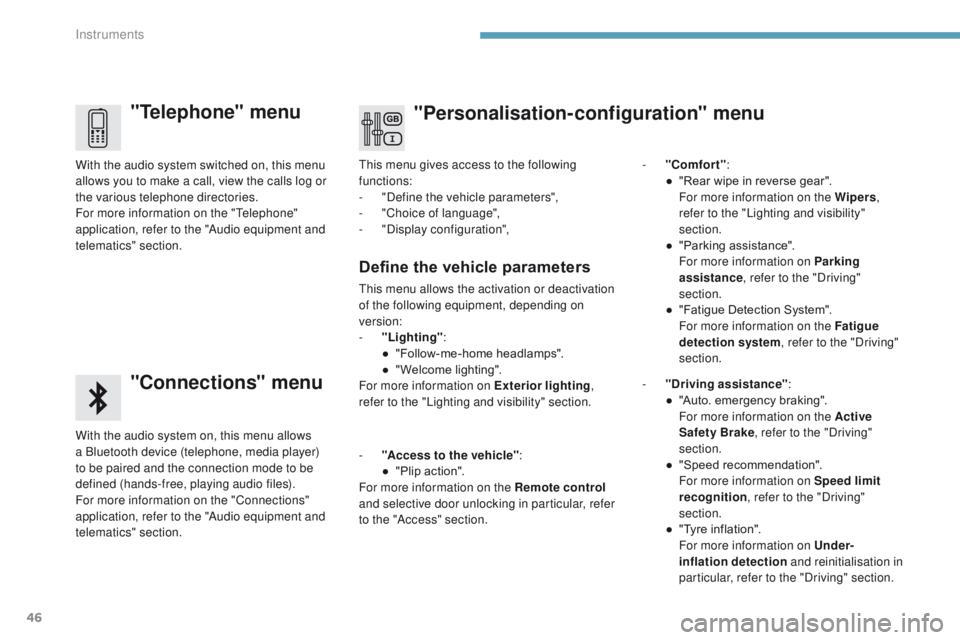
46
3008-2_en_Chap01_instruments-de-bord_ed01-2016
"Telephone" menu
"Connections" menu
With the audio system on, this menu allows
a Bluetooth device (telephone, media player)
to be paired and the connection mode to be
defined (hands-free, playing audio files).
For more information on the "Connections"
application, refer to the "Audio equipment and
telematics" section. With the audio system switched on, this menu
allows you to make a call, view the calls log or
the various telephone directories.
For more information on the "Telephone"
application, refer to the "Audio equipment and
telematics" section.This menu gives access to the following
functions:
-
"
Define the vehicle parameters",
-
"
Choice of language",
-
"
Display configuration",
-
"
Comfort"
:
●
"
Rear wipe in reverse gear".
F
or more information on the Wipers
,
refer to the "Lighting and visibility"
section.
●
"
Parking assistance".
F
or more information on Parking
assistance , refer to the "Driving"
section.
●
"
Fatigue Detection System".
F
or more information on the Fatigue
detection system , refer to the "Driving"
section.
Define the vehicle parameters
This menu allows the activation or deactivation
of the following equipment, depending on
version:
-
"
Lighting" :
●
"
Follow-me-home headlamps".
●
"
Welcome lighting".
For more information on Exterior lighting ,
refer to the "Lighting and visibility" section.
"Personalisation-configuration" menu
- "Access to the vehicle" :
● " Plip action".
For more information on the Remote control
and selective door unlocking in particular, refer
to the "Access" section. -
"
Driving assistance"
:
●
"
Auto. emergency braking".
F
or more information on the Active
Safety Brake , refer to the "Driving"
section.
● " Speed recommendation".
F
or more information on Speed limit
recognition , refer to the "Driving"
section.
●
"
Tyre inflation".
F
or more information on Under-
inflation detection and reinitialisation in
particular, refer to the "Driving" section.
Instruments
Page 69 of 566
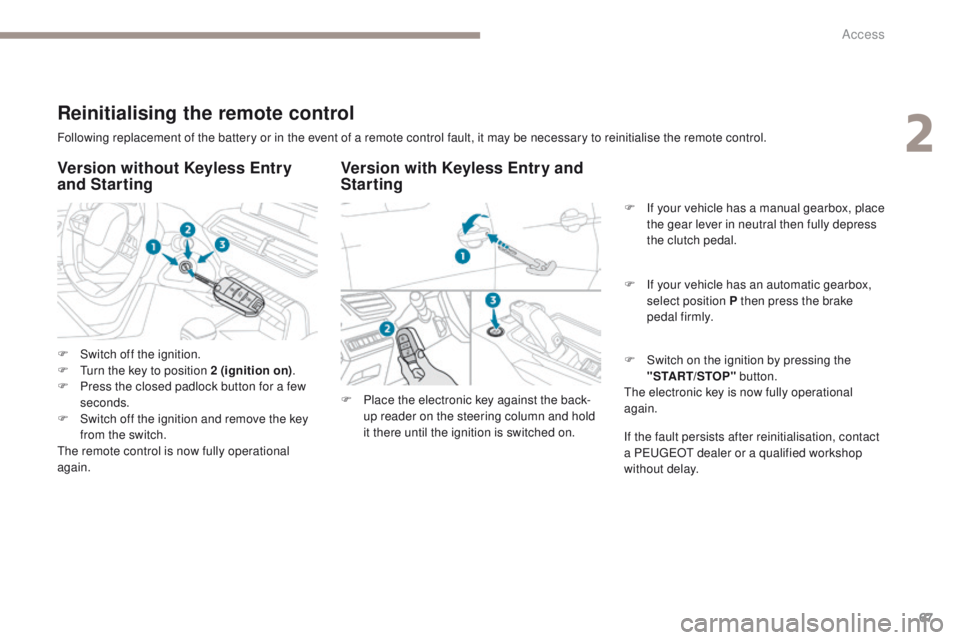
67
3008-2_en_Chap02_ouvertures_ed01-2016
Following replacement of the battery or in the event of a remote control fault, it may be necessary to reinitialise the remote control.
Version with Keyless Entry and
Starting
Reinitialising the remote control
Version without Keyless Entry
and Starting
F Place the electronic key against the back-up reader on the steering column and hold
it there until the ignition is switched on. F
S
witch on the ignition by pressing the
"START/STOP" button.
The electronic key is now fully operational
again.
F
S
witch off the ignition.
F
T
urn the key to position 2 (ignition on)
.
F
P
ress the closed padlock button for a few
seconds.
F
S
witch off the ignition and remove the key
from the switch.
The remote control is now fully operational
again. F
I
f your vehicle has a manual gearbox, place
the gear lever in neutral then fully depress
the clutch pedal.
F
I
f your vehicle has an automatic gearbox,
select position P then press the brake
pedal firmly.
If the fault persists after reinitialisation, contact
a PEUGEOT dealer or a qualified workshop
without delay.
2
Access
Page 162 of 566
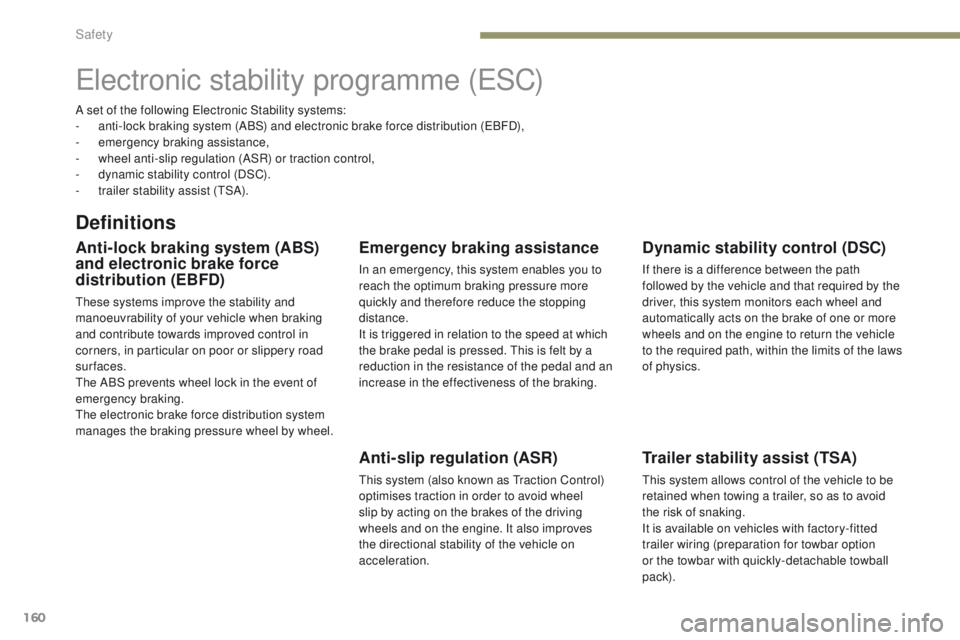
160
3008-2_en_Chap05_securite_ed01-2016
Electronic stability programme (ESC)
Definitions
Anti-lock braking system (ABS)
and electronic brake force
distribution (EBFD)
These systems improve the stability and
manoeuvrability of your vehicle when braking
and contribute towards improved control in
corners, in particular on poor or slippery road
surfaces.
The ABS prevents wheel lock in the event of
emergency braking.
The electronic brake force distribution system
manages the braking pressure wheel by wheel.
Emergency braking assistance
In an emergency, this system enables you to
reach the optimum braking pressure more
quickly and therefore reduce the stopping
distance.
It is triggered in relation to the speed at which
the brake pedal is pressed. This is felt by a
reduction in the resistance of the pedal and an
increase in the effectiveness of the braking.
Anti-slip regulation (ASR)
This system (also known as Traction Control)
optimises traction in order to avoid wheel
slip by acting on the brakes of the driving
wheels and on the engine. It also improves
the directional stability of the vehicle on
acceleration.
Dynamic stability control (DSC)
If there is a difference between the path
followed by the vehicle and that required by the
driver, this system monitors each wheel and
automatically acts on the brake of one or more
wheels and on the engine to return the vehicle
to the required path, within the limits of the laws
of physics.
A set of the following Electronic Stability systems:
-
a
nti-lock braking system (ABS) and electronic brake force distribution (EBFD),
-
em
ergency braking assistance,
-
w
heel anti-slip regulation (ASR) or traction control,
-
d
ynamic stability control (DSC).
-
t
railer stability assist (TSA).
Trailer stability assist (TSA)
This system allows control of the vehicle to be
retained when towing a trailer, so as to avoid
the risk of snaking.
It is available on vehicles with factory-fitted
trailer wiring (preparation for towbar option
or the towbar with quickly-detachable towball
pack).
Safety
Page 163 of 566

161
3008-2_en_Chap05_securite_ed01-2016
Anti-lock braking system (ABS) and electronic brake force
distribution (EBFD)
The fixed illumination of this warning
lamp signals that there is a fault with
the ABS.
Illumination of this warning lamp, coupled
with the STOP and ABS warning
lamps, accompanied by the display of a
message and an audible signal, signals
that there is a fault with the electronic
brake force distribution (EBFD).
You must stop as soon as it is safe to do so.
Call a PEUGEOT dealer or a qualified
workshop. When changing wheels (tyres and
rims), ensure that these are approved
for your vehicle. In emergency braking, press ver y
firmly and maintain this pressure. Normal operation of the ABS may make
itself felt by slight vibrations of the brake
pedal.
Intelligent traction control
system
Depending on version, your vehicle has a
system to help driving on snow: intelligent
traction control.
This system detects situations of difficult
sur face grip that could make it difficult to move
off or make progress on deep fresh snow or
compacted snow.
In these situations, the intelligent traction
control
limits the amount of wheel spin to
provide the best traction and trajectory control
for your vehicle.
The use of snow tyres is strongly
recommended on sur faces offering low
levels of adhesion.
The vehicle retains conventional braking. Drive
carefully at moderate speed.
Contact a PEUGEOT dealer or a qualified
workshop as soon as possible.
5
Safety
Page 164 of 566

162
3008-2_en_Chap05_securite_ed01-2016
Anti-slip regulation (ASR) / Dynamic stability control (DSC)
Operation
These systems are activated automatically
every time the vehicle is started.
They come into operation in the event of a
problem of grip or trajectory.
Deactivation
In exceptional conditions (starting a vehicle
which is bogged down, stuck in snow, on soft
ground...), it may be advisable to deactivate the
ASR system, so that the wheels can turn freely
and regain grip.
Reactivate the system as soon as the level of
grip permits.Deactivation is done in the Driving
menu of the touch screen.
Reactivation
The ASR system is reactivated automatically
every time the ignition is switched back on or
from 30 mph (50 km/h).
Below 30 mph (50 km/h), you can reactivate it
manually:
Operating fault
This is indicated by flashing of this
warning lamp in the instrument panel.
Illumination of this warning lamp,
accompanied by the display of a
message and an audible signal,
indicates a fault with the system.
Contact a PEUGEOT dealer or a qualified
workshop to have the systems checked.
It is confirmed by the display of a message.
The ASR system no longer acts on the
operation of the engine or the brakes in the
event of an involuntary change of trajectory.
ASR / DSC
These systems offer increased safety
in normal driving, but they should not
encourage the driver to take extra risks
or drive at high speed.
It is in conditions of reduced grip
(rain, snow, black ice) that the risk of
loss of grip increases. It is therefore
important for your safety to keep these
systems activated in all conditions, and
particularly in difficult conditions.
The correct operation of these
systems depends on observation of
the manufacturer's recommendations
regarding as much the wheels (tyres
and rims), braking and electronic
components as the assembly and repair
procedures used by PEUGEOT dealers.
To benefit in full from the effectiveness
of these systems in wintry conditions,
the vehicle must be fitted with four snow
tyres, allowing the vehicle to retain
neutral behaviour on the road.
After an impact, have these systems
checked by a PEUGEOT dealer or a
qualified workshop. Reactivation is done in the Driving
menu of the touch screen.
It is confirmed by the display of a
message.
Safety
Page 165 of 566
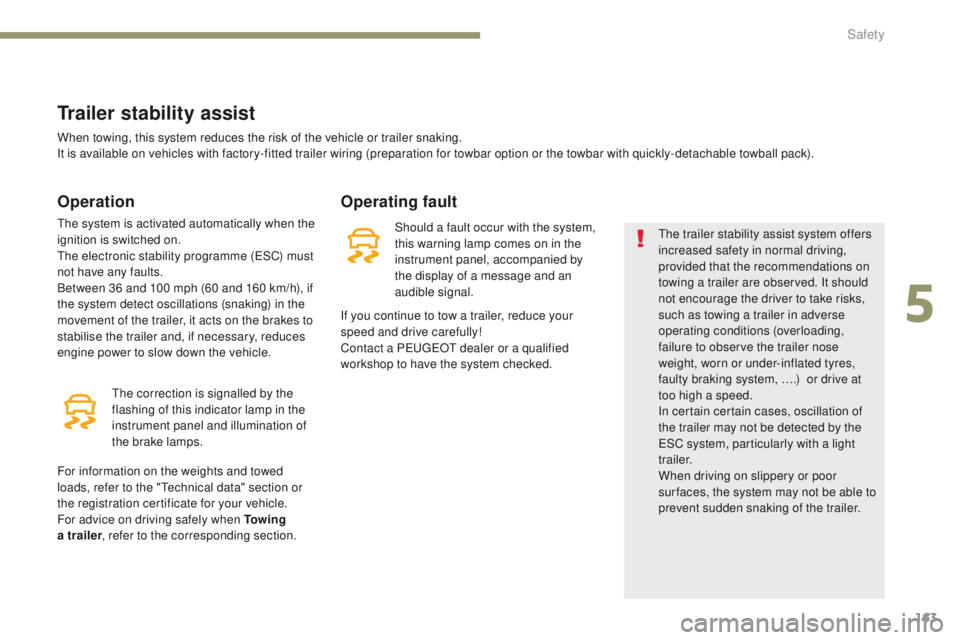
163
3008-2_en_Chap05_securite_ed01-2016
Trailer stability assist
Operation
The system is activated automatically when the
ignition is switched on.
The electronic stability programme (ESC) must
not have any faults.
Between 36 and 100 mph (60 and 160 km/h), if
the system detect oscillations (snaking) in the
movement of the trailer, it acts on the brakes to
stabilise the trailer and, if necessary, reduces
engine power to slow down the vehicle.
For information on the weights and towed
loads, refer to the "Technical data" section or
the registration certificate for your vehicle.
For advice on driving safely when To w i n g
a trailer , refer to the corresponding section.
When towing, this system reduces the risk of the vehicle or trailer snaking.
It is available on vehicles with factory-fitted trailer wiring (preparation for towbar option or the towbar with quickly-detachable towball pack).
The correction is signalled by the
flashing of this indicator lamp in the
instrument panel and illumination of
the brake lamps.
Operating fault
Should a fault occur with the system,
this warning lamp comes on in the
instrument panel, accompanied by
the display of a message and an
audible signal.
If you continue to tow a trailer, reduce your
speed and drive carefully!
Contact a PEUGEOT dealer or a qualified
workshop
to have the system checked. The trailer stability assist system offers
increased safety in normal driving,
provided that the recommendations on
towing a trailer are observed. It should
not encourage the driver to take risks,
such as towing a trailer in adverse
operating conditions (overloading,
failure to observe the trailer nose
weight, worn or under-inflated tyres,
faulty braking system, ….)
or drive at
too high a speed.
In certain certain cases, oscillation of
the trailer may not be detected by the
ESC system, particularly with a light
t r a i l e r.
When driving on slippery or poor
sur faces, the system may not be able to
prevent sudden snaking of the trailer.
5
Safety
Page 168 of 566
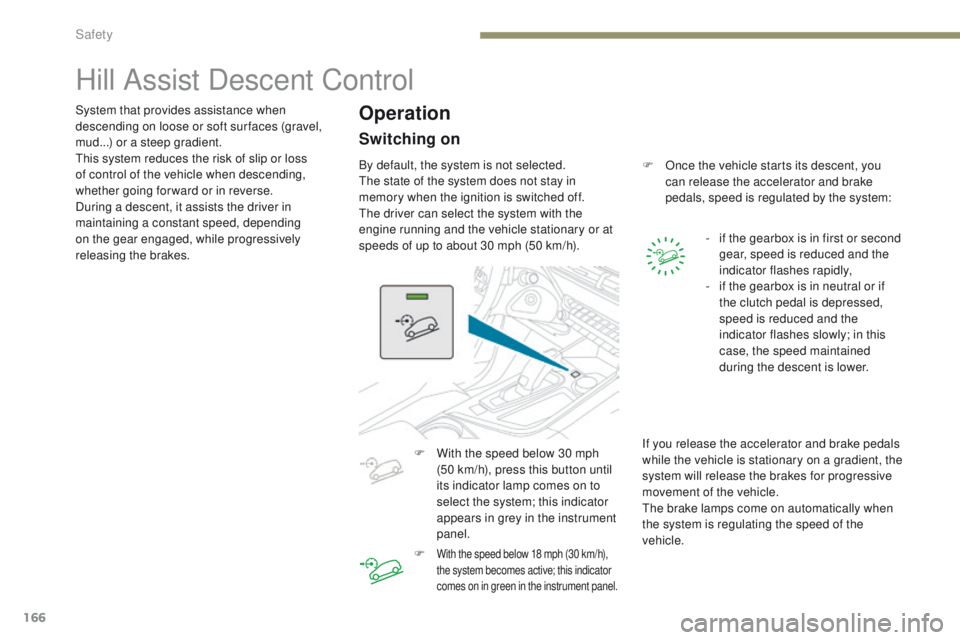
166
3008-2_en_Chap05_securite_ed01-2016
Hill Assist Descent Control
System that provides assistance when
descending on loose or soft sur faces (gravel,
mud...) or a steep gradient.
This system reduces the risk of slip or loss
of control of the vehicle when descending,
whether going forward or in reverse.
During a descent, it assists the driver in
maintaining a constant speed, depending
on the gear engaged, while progressively
releasing the brakes.Operation
By default, the system is not selected.
The state of the system does not stay in
memory when the ignition is switched off.
The driver can select the system with the
engine running and the vehicle stationary or at
speeds of up to about 30 mph (50 km/h).F
O nce the vehicle starts its descent, you
can release the accelerator and brake
pedals, speed is regulated by the system:
-
i
f the gearbox is in first or second
gear, speed is reduced and the
indicator flashes rapidly,
-
i
f the gearbox is in neutral or if
the clutch pedal is depressed,
speed is reduced and the
indicator flashes slowly; in this
case, the speed maintained
during the descent is lower.
Switching on
F With the speed below 30 mph (50 km/h), press this button until
its indicator lamp comes on to
select the system; this indicator
appears in grey in the instrument
panel.
F
With the speed below 18 mph (30 km/h),
the system becomes active; this indicator
comes on in green in the instrument panel.
If you release the accelerator and brake pedals
while the vehicle is stationary on a gradient, the
system will release the brakes for progressive
movement of the vehicle.
The brake lamps come on automatically when
the system is regulating the speed of the
vehicle.
Safety